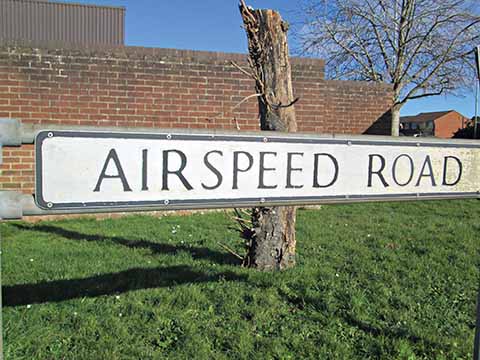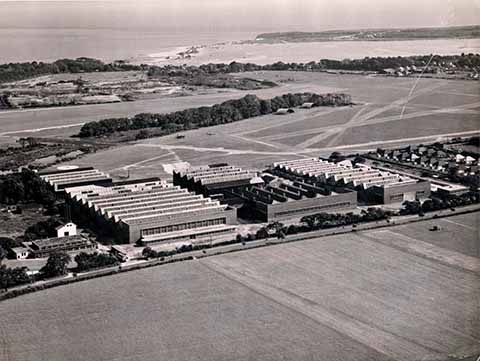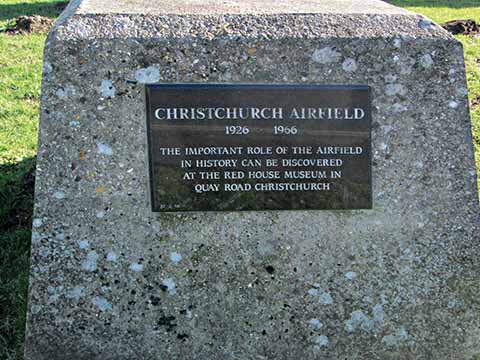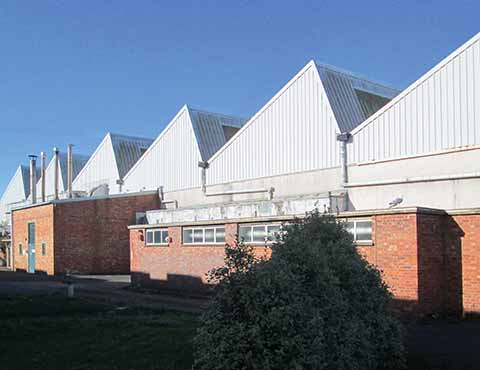Flying high in Christchurch
Peter Blake looks at Christchurch’s aeronautical past
Published in March ’19
Like many Christchurch residents, I was vaguely aware of a tradition of aviation in the town. There are not many tangible clues still existing, but several hints may still be found. These include street nameplates commemorating flying and famous aircraft, for example Halifax Way, Valiant Way, Brabazon Drive, Ambassador Close, Auster Close, Dakota Close and, of course, Airfield Way and The Runway. However, reading about Neville Shute led me to the Airspeed company, and further investigation unveiled the major role Christchurch played in the development of the British aviation industry, at a time when Britain was firmly in the forefront of world aviation.
Commercial flying had started in Christchurch as early as 1926, with Surrey Flying Services operating from the area known as Burry’s Field, part of Mudeford Farm, and later Fisher Aviation Company, amongst others, offering flights from fields close to Somerford Road. In 1934 Francis Fisher established an aerodrome on what had become known as Christchurch Airfield. This prompted some opposition in the town, as the previous year the noise from a National Aviation Day, which was unofficially known as Alan Cobham’s Flying Circus and had attracted 8000 spectators, had disrupted Matins in the Priory, to the displeasure of many local worthies. However, in 1934 the planning application was permitted on appeal and from early the following year the airfield became known, temporarily, as Bournemouth Airport. Alan Cobham was a pioneer of long-distance aviation and went on to establish what is now known as Cobham plc, a multi-national aviation services company based in Wimborne. In 1937 Jean Batten landed at Christchurch, having completed a solo flight from Australia to England in the then record time of 5 days, 18 hours and 15 minutes.
In the early 1930s, N S Norway, a young aeronautical engineer, was looking for a new job. He had been Barnes Wallis’s deputy on a project to develop commercial airship routes across the Empire, becoming Chief Engineer when Barnes Wallis left. This project came to a halt when R101, the second airship, crashed in France in 1930 on its maiden voyage, killing 48 people. Norway, who later went on to achieve greater fame writing under his pen-name as novelist Neville Shute, teamed up with aircraft designer A H Tiltman to found Airspeed Ltd in York in 1931. Alan Cobham was also a founding director.
As the company expanded, more space was needed and it moved to Portsmouth in 1933. By 1940 it had become a wholly owned subsidiary of the de Havilland Aircraft Company but still retained its identity as a separate concern. Neville Shute had left the company by this time, he and Tiltman being in conflict over the direction the company should take. Shute was then able to pursue his literary career, which led to worldwide recognition. His contribution to aviation should not be downplayed, however – he was made a Fellow of the Royal Aeronautical Society for his work on the R101 and for developing a hydraulic retractable undercarriage for the Airspeed Courier.
Also in 1940, Airspeed was given the task of running an aircraft production factory in Christchurch, operating as a shadow factory to the Portsmouth plant. Shadow factories arose from the Shadow Scheme, devised in 1935 to increase aircraft manufacturing capability in preparation for any forthcoming conflict. During World War 2 the airfield became known as RAF Christchurch, and I later managed the site. It included the barrack block, which still had the remnant of the flagpole in the front car park and traces of the communications network in the lower corridor, protected by heavy steel blast doors at either end. This area is under development to provide housing at the time of writing.
Situated at the north of the airfield, on part of Fisher’s Field, the factory officially opened in 1941. Initially the factory was producing the Airspeed Oxford, a twin-engine training aircraft. Over 500 Oxfords rolled out of the factory, one of which Amy Johnson was flying when she disappeared in 1941. That same year, great excitement was caused by the arrival of a Bücker Jungmann biplane, stolen from the German aerodrome in Caen by two French Air Force pilots.
The Oxfords were followed by the air assault Horsa gliders, which went from design to air in ten months. Airspeed in Christchurch built nearly 700 of the 3600 Horsas produced nationwide and was the only location where gliders were assembled and test-flown from the same site. Production of the remainder was spread around, using sub-contractors including furniture-makers, who had the skills and equipment required to manufacture wooden aircraft. Capable of carrying 30 fully equipped paratroopers, the Horsa was used in a number of air assault operations in Norway, Sicily and Normandy. Other wartime aircraft constructed at Christchurch were the Mosquito fighter bomber, which was nicknamed the Wooden Wonder and was one of the fastest operational aircraft in the world when production began in 1941, and the Supermarine Seafire fighter, a naval version of the Spitfire adapted for operations from aircraft carriers.
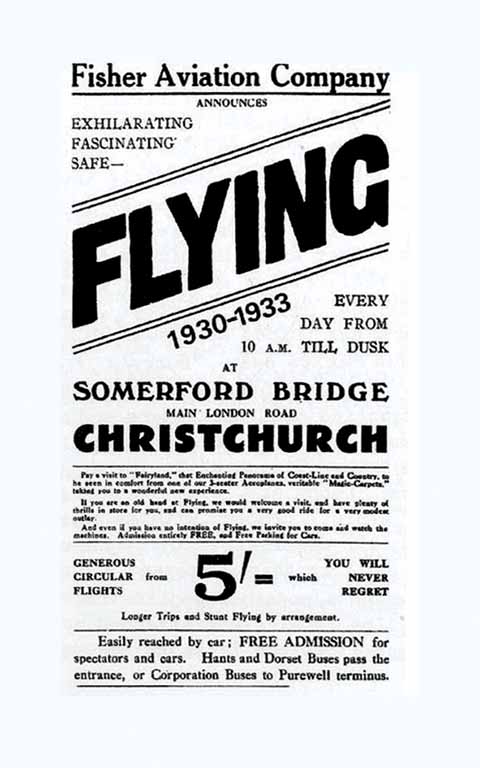
Below The Fisher Aviation Company invited locals to ‘Visit fairlyland – the enchanting panorama of coast-line and country’ by taking a flight from Christchurch
Christchurch Airfield was taken over in 1944 by 405 Fighter Group, USAAF Ninth Air Force, one of several airfields in the New Forest area at that time which were required to provide tactical air support for the ground forces who would be landing in Normandy. Following the departure of the USAAF, the airfield returned to the control of RAF Transport Command in early 1945, then the Ministry of Aircraft Production the following year.
The company reverted to the name Airspeed Ltd in 1944 and moved into the commercial market, producing for example the Ambassador, sometimes referred to as the Elizabethan, which first flew in 1947 and served for many years with British European Airways. After disposal by BEA, the Ambassador went on to be used by Dan-Air to establish their scheduled and charter operations. By 1951 Airspeed had merged completely with de Havilland and three years later around 2000 people worked on the site, making it a major employer in the area with a sports facility located at Wingfields in Highcliffe. Aircraft produced in this period included the Vampire, the Sea Venom and later the Sea Vixen. The site finally ceased production in 1962. Some of the original buildings remain, the rest being sold off for housing and new businesses. From 1984 to 2000 a Sea Vixen stood proudly on Somerford Road, close to the site of the original factory, as a striking and powerful reminder and landmark, but it was removed for safekeeping to Tangmere Military Aviaton Museum to protect it from further damage at the hands of vandals and the weather. It has now been restored and is on permanent display.
Following the closure of the de Havilland factory, use of the airfield rapidly declined. Commercial flying had switched to Hurn, which was Britain’s only intercontinental airport from 1944 until Heathrow became fully operational in 1948. Although Christchurch Aero Club and a glider school still operated from the field after this time, its days were numbered. The air traffic control tower was closed in 1963, and the Aero Club went the same way the following year. Today the airfield site has been redeveloped, leaving scant reminders of the bustle of aviation industry which once took place. Part of the Airspeed factory was later taken over by Revvo Castors until being demolished in 2011 and redeveloped as a car showroom. Some of the original factory units still stand on Somerford Road and are now used as storage facilities for the Office of National Statistics, holding old census returns, passport information and health and social care records.
Although Airspeed Ltd, the airfield and aircraft production are no longer part of Christchurch’s technological landscape, the link with aviation has not been completely broken. De Havilland, with whom Airspeed fully merged in 1951, was bought by Hawker Siddeley in 1960, which itself later became part of British Aerospace, now BAE Systems, still present in the town on Grange Road, on the site of the airfield. Although the signs of Christchurch’s aviation history are less apparent nowadays than they once were, the links with the past stretching back over ninety years have not been completely broken if you know where to look.
For more information, the Hampshire Airfields website is excellent,
www.hampshireairfields.co.uk/, as is the Friends of the New Forest Airfields, at
https://fonfasite.wordpress.com/

